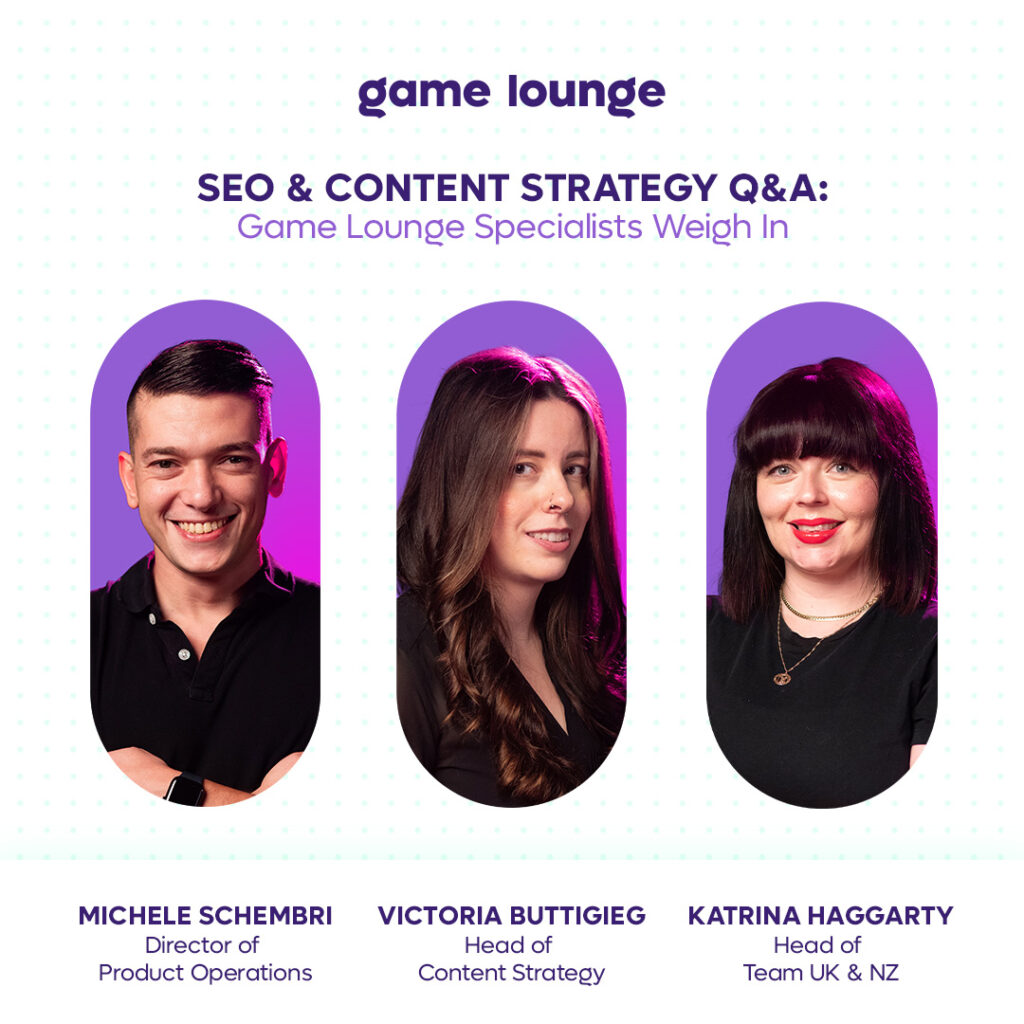- Insights
- Blog
SEO & Content Strategy Q&A: Game Lounge Specialists Weigh In

And three Game Loungers are ready to share their insights on how E-E-A-T and other practices turn good content into great content.
Katrina Haggarty leads the UK and NZ casino team, managing a group of content managers and writers. In her world, words, perspectives, and research hold significant importance, and she has ample experience tailoring work to achieve results. Michele Schembri, our director of product operations, always has his finger on the pulse of what’s happening next on the technical side of things. Finally, Victoria Buttigieg, our Head of Content Strategy, knows a good piece of content when she reads it.
Here’s what they have to say.
Q: Talk to us a little bit about your role in content production. Do you often collaborate on the content streams you use, or is there another process in place?
Katrina: I manage a team that produces content for two casino sites tailored to the UK and NZ, focusing on product roundups, reviews, and offers that help casino customers to make informed decisions. Our UK and NZ teams create, research, and edit localised iGaming content alongside insights from our SEO colleagues. We then collaborate using tools like Google Docs and Jira to get stakeholder approvals before publishing onsite.
Q: How do you select which content to focus on at any given time?
Katrina: We prioritise content based on search data and user demand. Analysing keyword trends, search volumes, and competitive gaps to help us identify topics with the highest potential value. We focus on content types that align with what our users are looking for—like the newest casinos to launch, slot reviews, and promotions—and adjust based on seasonal trends and regulatory changes.
Q: What practices do you use besides EEAT to ensure that your content ranks highly?
Michele: We focus on practises beyond EEAT. These would include a focus on user intent, content freshness, comprehensive topic coverage, and on-page SEO. Other technical factors like load speed, mobile optimisation, and strong internal linking, even though they don’t provide clear ranking signals, are other factors that are constantly taken into consideration.
Q: Google is well known to change its algorithm and ranking criteria often. Do you have a particular way you stay on top of this when you’re drafting content? Is it something that you plan for in advance, or do you test out different methods once the algorithm change happens?
Katrina: Staying on top of Google’s algorithm changes is essential to our content strategy at Game Lounge. We monitor updates and collaborate with our SEO team to adjust our strategy. When changes roll out, we analyse the impact on our content and implement optimisations, such as keyword adjustments, internal linking, and content enhancements, to maintain or improve rankings.
Q: Talk us through the process of creating a piece of content. How does it work? What do the early stages of content creation look like?
Katrina: Our content production starts with comprehensive SEO and market research to find high-value topics that meet our users’ intent. Once we identify a topic, we create a detailed content brief to help the writer with the structure, key points, and goals of the piece. The brief is then passed over to the writer, who researches the topic In detail and drafts the content.

Q: Google’s latest change has placed a greater emphasis on the author. How do you work around this latest change, and ensure that Google ranks your produced content fairly?
Michele: Even though it’s not always straightforward, we always aim to emphasise the author. We tend to highlight author expertise by building detailed author bios, showcasing credentials where possible, and including links to the author’s published work. By striving for transparency, we aim to strengthen credibility.
Q: Were there any significant changes in the past that have affected how you create content today? Would you tell us a little bit about them?
Michele: Major updates like the Helpful Content and Core Web Vitals emphasised user-focused, high-quality content and technical performance. I believe it’s safe to say that long gone are the days of creating a long piece of content, and stuffing keywords to manipulate the SERP. Good things often come in small packages, and the same goes for content. We don’t need lengthy articles anymore; as long as the content directly addresses users’ questions, it’s impactful and effective.
Q: What is your professional opinion of EEAT – is it something that’s here to stay, or will we see more developments in the future with regards to Google’s algorithm, and specifically its algorithm’s approach to verifying results?
Michele: EEAT is foundational to Google’s approach to ranking and is likely here to stay. However, questions remain about how Google can reliably verify an author’s authenticity, as some still manage to build credibility behind fictitious personas. We can expect continued developments, especially with AI-driven accuracy checks, to address these challenges.
Q: What would you like to see in the future of content creation?
Michele: I believe a more data-driven, personalised approach can help anyone stand out in a vast sea of content. Ideally, addressing user intent would seamlessly connect us with our audience, but in the SEO world, we constantly face content cannibalisation when creating pieces that overlap. AI is here to stay and will continue to evolve, offering tools that can elevate content creation. Complex LLM is not a means to an end, but rather a means to getting there faster and more effectively.
Q: What does the ideal piece of content look like for you?
Victoria: The ideal piece of content is one that’s clear in its purpose for its readers, the brand, and the business. It follows on-page SEO best practices and is signed by a reputable author with expertise in the subject matter. It’s in-depth and conveys EEAT values whilst remaining skimmable.
To achieve this, the content is well-structured, clearly formatted, answers clear questions (this is beneficial for voice search too), and includes multimedia elements like images and videos. The latter not only makes the piece more interesting to read, but also provides the page with the opportunity to rank in other ways.
Interactive elements like a comparison tool or bonus calculator help make the content more actionable and increase the time readers spend on the page. It’s also essential that the references and claims made in the content are up-to-date, cited from credible sources and market-relevant. Above all else, the ideal piece of content is worth reading.



From left to right in the above images: Victoria Buttigieg, Michele Schembri, and Katrina Haggarty.
